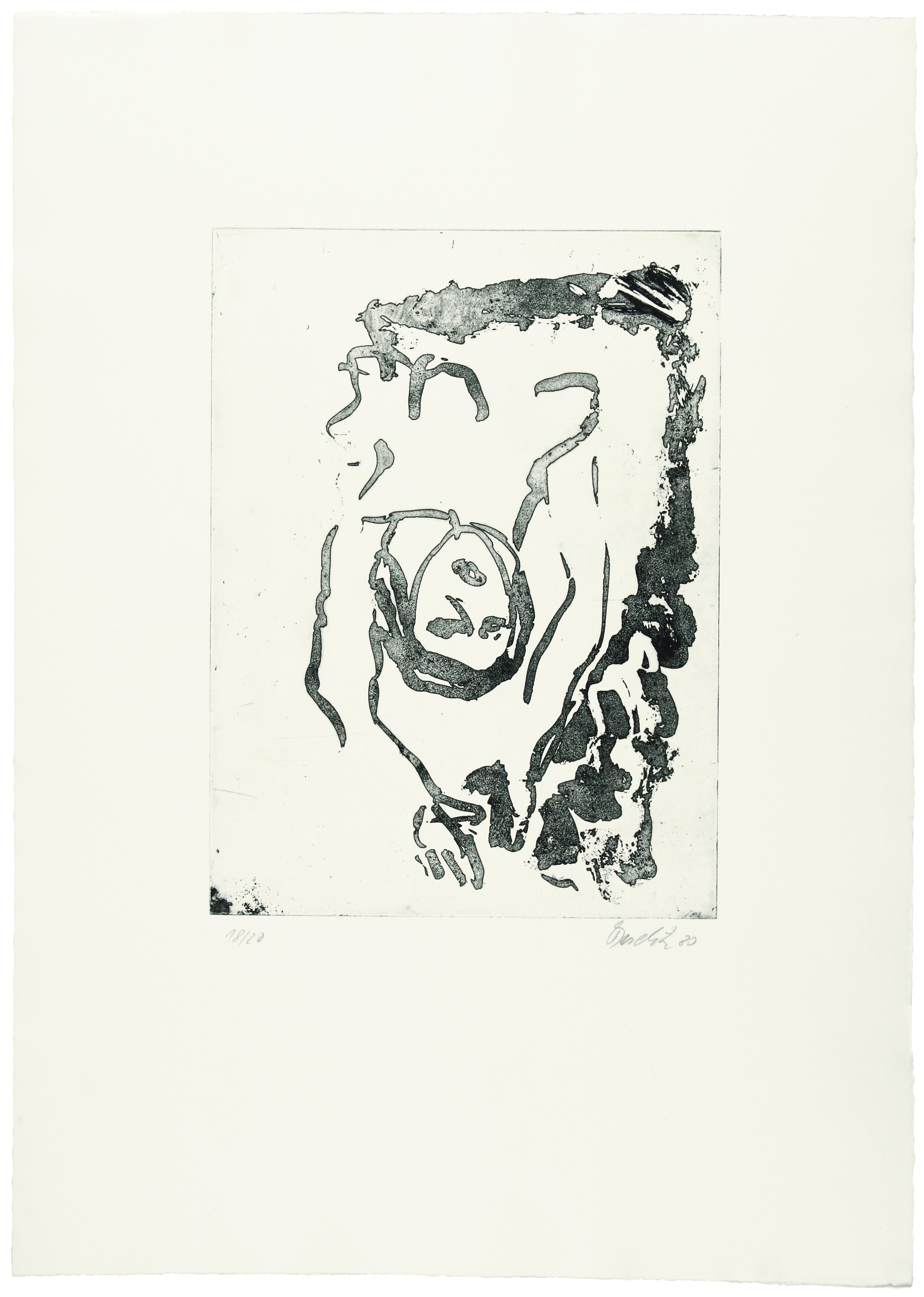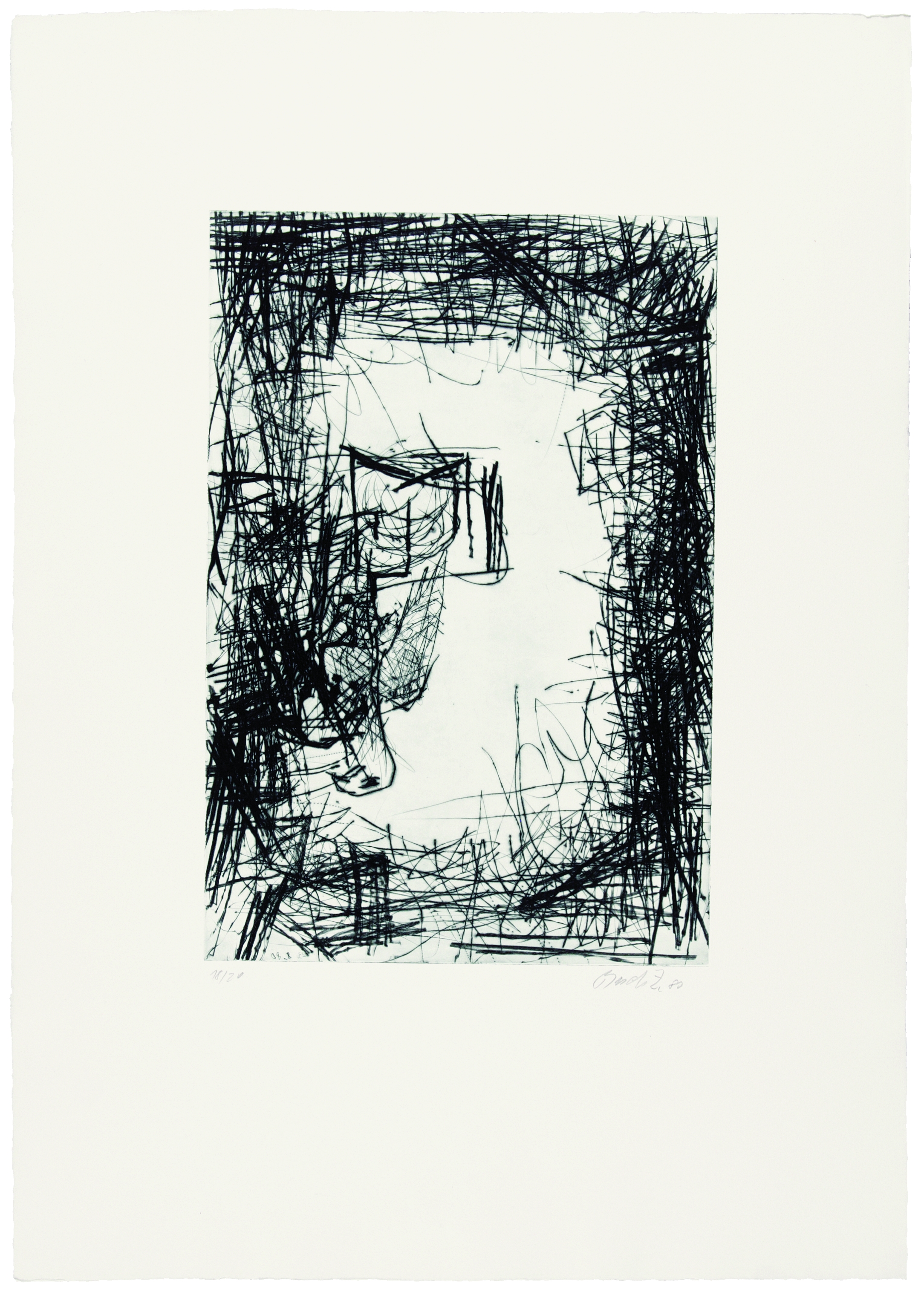Folder with nine drypoint and aquatint etchings on handmade paper
Dimensions: 78.7 x 56 cm each
Signature, inscriptions, markings: each signed and dated at lower right, numbered at lower left
Copy Number: 18/20
Publisher: Maximilian Verlag, Munich
Accession Number: 1001094.1–9
Images: Sheet 4 and 6
The title Eagle, Tree, Woman in Window ... names some of the motifs in the portfolio.1 The eagle in particular is frequently encountered in Baselitz's work. However, according to his own words, the artist chooses his motifs rather arbitrarily. The eagle is a symbol of divine and sovereign power, an attribute of the evangelist John, and a frequently used heraldic animal. Yet it supposedly has no special significance in Baselitz's work. "And all the things (...) are to be understood as provocation. The objects or motifs are pulled out of one's fingers, pulled out by the hair."2 Since 1969 Baselitz has been working with the inversion of pictorial motifs: the upside-down is itself a formal motif that he uses again and again: "The problem is not the object in the picture, but the problem is the picture as object. And this question of what is being handled there (...) it simply doesn't arise," the artist indicates, because "the object expresses purely nothing. (...) And I said to myself, if this is so, then I must take all that has always been the subject of painting - for example, landscape, portrait, nude, and paint it in reverse. That is the best way to free a representation from its content."3
The sheets in this portfolio differ in their brightness and expression. The depiction titled Waving Woman was created in aquatint technique and appears soft and two-dimensional. The loosely drawn sheet has only a few curved blotchy lines outlining the figure. The posture of the woman is clearly visible. As a contrast, the sheet Eagle, a drypoint etching. The strokes here are aggressive, sharp-edged and expressive. The subject moves to the left out of the center of the picture and the contours of the eagle blur in the black dotted border zone, which encloses the representation and takes up almost half of the sheet. Even more contrasting are the two sheets Untitled, also drypoint etchings. While one of them, in its light-dark relations, looks like the negative of Eagle and could also represent the same motif, the expressiveness of the other is heightened to such an extent that it is no longer possible to interpret its content; at best, echoes of vegetative or crystalline forms can be discerned.
In each case, the view is directed to a center. Baselitz had already begun to compose his pictures at the end of the 1950s in such a way that the viewer is offered a point of reference.4 Such centers can also be found in the prints of the portfolio. They draw the eye, even if they are not in the center of the sheet. By reversing his motifs, Baselitz had succeeded in suspending the meaning of essential themes of art history, the figure, the landscape, the portrait, the nude, heraldic symbols, without letting them disappear. At the same time, the freedom of artistic representation becomes all the more apparent. In this context, it is perhaps not unimportant to know that Baselitz himself is one of the world's most important collectors of the virtuoso print art of Mannerism.5
Katrin Schmidt
1 Fred Jahn, in collaboration with Johannes Gachnang, Georg Baselitz. Werkverzeichnis der Druckgraphik, vol. II (1974-82), Bern/Berlin 1987, Wv. No. 239-247, pp. 96-105.
2 Georg Baselitz, ed. by Benedikt Taschen, Hamburg/Wittingen 1990, pp. 8f.
3 Ibid, p. 158, p. 88.
4 Georg Baselitz in conversation with Heinz Peter Schwerfel, Cologne 1989, p. 45.
5 Cf. exhib. cat. La bella maniera. La collection d’estampes maniéristes de Georg Baselitz, hrsg. v. Emmanuelle Brugerolles, École Nationale Supérieure des Beaux-Arts, Paris 2002.

